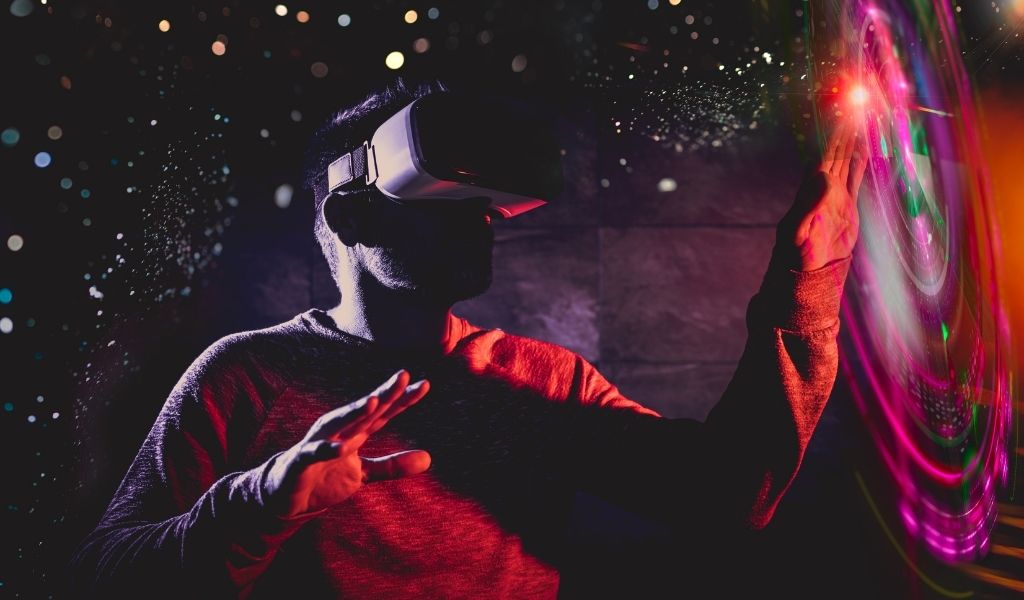How Will The Metaverse Affect The Future Of Work?
How and when will the metaverse impact our working environments? It depends. The metaverse might drastically affect how we do business. Some examples are inspiring field trips to the Louvre, quicker learning, and reimagined onboarding. It is unclear, however, how exactly a 3D internet — the shorthand for the metaverse — might impact workplace conditions. That is because the technology required to alter processes radically is not yet fully developed and partly because it is unknown how consumers will use the metaverse.
According to proponents, virtual worlds of the metaverse will foster teleworker camaraderie, boost collaboration, expedite training, remove the need for office space, and make work more fun. At least, such is the promise of ideas like this one from social media tycoon Mark Zuckerberg, whose rebranding of Facebook as Meta in late 2021 generated business interest in a concept that is both outdated and imaginary. This Article provides the most up-to-date thoughts about how and when the metaverse may impact work settings.
What is the metaverse exactly?
In his 1992 novel Snow Crash, science fiction writer Neal Stephenson used the term “metaverse” to depict a shared, continuous 3D digital world in which people work and play. Matthew Ball, the author of what is widely considered to be one of the best introductions to the metaverse, cites the following qualities of this world:
Real-time, massively scalable, interoperable 3D; synchronization and durability; and world-spanning continuity of data, identity, history, entitlements, objects, and payments. Ball and others have noted that the technology required to execute many of these essential traits is still being developed. 3D settings, for instance, do not scale well beyond a few hundred people watching a conference broadcast, and they support even fewer users if the interaction is necessary. There is currently limited continuity of history, rights, and objects across virtual worlds. It may require five to 10 years to overcome the requisite technical obstacles. The conclusion of business agreements and data protection issues may need much more time.
Therefore, the temporality of the metaverse depends on who is speaking and the level of complexity under consideration. Microsoft’s chairman and CEO, Satya Nadella, has said that the metaverse is already a reality if we consider applications like HoloLens overlays for production floors and Mesh Team Meetings. Zuckerberg predicts that an “embodied” metaverse will become the norm over the next five to 10 years, presuming we are referring to larger-scale virtual worlds that we can access via high-performance technology.
How to adapt the metaverse for occupational purposes?
Creating the metaverse for work will require firms to reconsider how workers use new digital technologies rather than just changing the present workplace into a virtual office. Early study suggests that even changing existing workspaces into 3D versions might reduce productivity and trigger nausea and motion sickness. Here are the viewpoints of four professionals on the metaverse change in employment: Senior principal analyst at Gartner Tuong H. Nguyen described the current solutions as “precursors” or “pre-metaverse.” Although no one can forecast how the metaverse will evolve — much alone its impact on any market sector, industrial vertical, or geographic location — these pioneers provide an educated approximation of how it may affect us.
One of these precursors is virtual reality (VR), which Nguyen emphasized is not the metaverse. Virtual reality, he noted, is an experience or interface, but the metaverse is a digital environment. In addition, VR is just one of many ways to interact with this digital world, and it is neither the most important nor the most popular interface. Gartner, according to Nguyen, considers the usage of virtual reality to improve meetings, product setup, product design, decision-making, onboarding, and training to be beneficial.
The entire physical destination of #Yas Island will be recreated in the #metaverse. Users will be able to purchase digital homes, discover cultural attractions and visit theme parks from their homes.#crypto #metaversenews #YasIsland #AbuDhabi pic.twitter.com/17qHGl5CuL
— Zee (@digitalsamurai8) October 31, 2022
Andrew Hawken, co-founder and CEO of Mesmerise, a firm that produces 3D collaboration tools, believes that the metaverse “has the potential to shrink the world in the same way that the internet did in the 1990s.” However, he emphasized the need to establish reasonable expectations for the usefulness of developing metaverse precursors such as virtual reality. Hawken underlines that virtual reality is not a “daily tool.” His team has shown that the best session length for a virtual reality meeting is typically 20 minutes.
Frank Diana, managing partner and futurist at Tata Consultancy Services (TCS), compares the transition to the metaverse in the workplace to the change from typing pools to the widespread use of personal computers. Even though operating in the metaverse will ease several processes, it presents a danger to several existing jobs. Diana said, “We must reskill individuals in order to teach them how to operate effectively in the metaverse, so that capable persons are not left behind and become technologically unemployable.”
Remote work gives a method. Marcel Hollerbach, chief innovation officer of Productsup, a product information management platform, said it is crucial to approach the metaverse cautiously to understand what works and creates problems. According to him, by incorporating the metaverse into the fundamental structure of remote work, employees will become more used to and receptive to the goal of the technology. Use cases for the metaverse from the employee and customer viewpoint.
Here are some of the most widespread uses of labor in the metaverse:
1. Attempting to simulate cohabitation
“We’ve all discovered that co-presence — the sensation of being in the same room with someone — has many benefits in terms of communication, engagement, morale, and team culture, among others,” said Hawken. As a result of working from home or in many locations, employees are becoming separated. New metaverse experiences may imitate our social interactions at gatherings and events. The supporting technologies may include spatial audio to help place persons in a virtual world, new techniques for arranging larger groups of people on a 2D screen, and immersive 3D virtual reality experiences.
“The ability of the metaverse to provide experiences that are as collaborative and socially satisfying as face-to-face interactions will enable companies to establish very dispersed and diverse workforces,” Diana said.
2. Enhancing teamwork and collaboration
New metaverse experiences might enhance collaboration beyond what is achievable in the physical world. Whiteboards, post-it notes, and large-screen monitors are popular brainstorming equipment. What if the metaverse offered unlimited 3D collaboration possibilities, and the team could go to the Louvre for inspiration? Diana asked. If working remotely in the metaverse boosts productivity and collaboration and will utterly overturn the existing office paradigm.
Matterport, a technology company whose 3D modeling software simulates genuine locations digitally, has created digital twin procedures that allow remote collaboration, learning, and worker engagement. For instance, architects may communicate virtually with clients on remodeling plans to make decisions more quickly, and retailers can work virtually on alternative store layouts to uncover challenges or opportunities more quickly. Matterport’s vice president of communications and business relations, Steve Lombardi, said, “All of this has the potential to result in high cost and time savings for enterprises.”
3. Fostering a corporate culture
Hollerbach said that his team began experimenting with new metaverse technologies to alleviate the boredom of chatting with restricted social interaction possibilities on a screen. That has benefited team-building activities, business events, and employee training.
“It brings a whole new approach to social interaction,” he said. “You are drawn into the same environment as your colleagues, as opposed to feeling thousands of miles off from them. In addition, the metaverse’s products fascinate people “said Hollerbach
4. Assessment of procedures
The metaverse might also make it easier for executives to visit a factory, distribution center, or construction site in another city or country, enabling them to examine the existing state of things, model the effect of potential changes, and cooperate with distant personnel to address issues.
“They will be able to watch and engage with its equipment, shake hands with the local supervisor, and monitor its operations without leaving their desk,” Emmanuelle Rivet, vice chair, U.S. TMT and Global Technology Leader, said PwC.
5. Accelerating the learning process
Interactive gaming and instructional simulations will be possible in the metaverse. The metaverse could enhance strategies for skill development and training. Daniel Fallmann, CEO and co-founder of Mindbreeze, a knowledge management platform, said that staff might learn to run a machine as if it were “real” or practice a sales speech for a high-paying client, to mention just two examples. “No longer will new hires rely on manuals and training guidelines,” he continued.
Also read, Past And Future Products And Acquisitions For Google Metaverse
6. Redesigned welcome
In the following years, Diana anticipates that mixed reality and metaverse training and onboarding sessions will become the industry standard. He continued, “The metaverse will allow us to radically redesign the onboarding process rather than just extending the present in-person onboarding to virtual reality.” Instead of reading a paper or viewing a video on the company’s history, new employees may meet the company’s founder or visit the workplace. Additionally, the metaverse might enhance social connections between recruits and their new coworkers.
7. Improving safety
Induction into the metaverse might help reduce the threats faced by first responders, hospital emergency personnel, and the military. Diana said, “Dangerous and stressful circumstances may be simulated in a way that prepares these individuals for real-world situations without putting them in danger and, ultimately, at a far lower cost.”
8. Minimizing office costs
The general use of metaverse platforms might increase employee engagement regardless of geography. Yugal Joshi, a partner at the consulting firm Everest Group, said, “This will enable organizations to hire employees without having to maintain physical offices.”
Difficulties associated with moving work to the metaverse
The metaverse is not a given conclusion for most organizations or even some of the most prominent use cases listed above. Unique is the act of making a spectacular entrance. For the metaverse to acquire speed, ergonomics, security, and procedures must be handled, among other barriers.
Metaverse fatigue: In a recent German study, transferring desk-based tasks into virtual reality for one week showed severe ergonomic issues. Two of the sixteen participants were forced to withdraw due to simulator sickness, while the other fourteen suffered from decreased performance, eyestrain, and dissatisfaction. However, there was evidence that people overcame their initial discomfort with time.
Diana said, “We have heard about Zoom fatigue during the first move to remote; we may face metaverse fatigue if enhanced user experiences are not guaranteed.”
Reduced multiculturalism and diversity. According to Joshi, creating an inclusive, diverse, and equal-opportunity workplace is challenging enough in the real world. He fears that inappropriate use of the metaverse might impede growth. Sexual assault and harassment of female avatars are already occurring in the metaverse. Moreover, many of today’s relatively simple apps are inaccessible to persons with disabilities, and the metaverse will be more complex. Accessing metaverse platforms may also need the purchase of expensive, out-of-reach equipment. Even today, employees without access to broadband Internet may be excluded from team activities.
Privacy and safety threats. In the metaverse, businesses will face new security threats and privacy issues. Augmented reality (AR), mixed reality (MR), and virtual reality (VR) technology gather voluminous biometric data, face traits, and unique movements. “These might be used to steal identities or even create obtrusive deepfakes if they are not protected,” Diana said.
AR and VR are incorporated into procedures. To complement existing solutions, Nguyen said enterprises must also work out the kinks in augmented reality and virtual reality capabilities. Similar to how organizations must assess when video chats make the most sense, they will need a continual procedure to determine if AR and VR are appropriate.
The development of work is an ongoing process.
To attempt to grasp the metaverse will be a literal difficulty. “The metaverse is neither a physical place nor an item,” remarked Nguyen. “The metaverse is an evolution of the internet,” he said, adding that companies cannot predict how it will develop or where they will fit inside it.
Each organization must study how the nature of work may change in response to an immersive digital environment and permanent, decentralized, collaborative, interoperable digital content. Digital information attached to equipment will enable new maintenance and installation methods for staff and customers. Opportunities in retail may be altered by adaptive digital signage and price tags. Collaborative 3D simulations will change how we make difficult decisions; this is just one of the many ways virtual worlds will influence the workplace.
Stay informed with daily updates from Blockchain Magazine on Google News. Click here to follow us and mark as favorite: [Blockchain Magazine on Google News].
Get Blockchain Insights In Inbox
Stay ahead of the curve with expert analysis and market updates.
latest from tech
Disclaimer: Any post shared by a third-party agency are sponsored and Blockchain Magazine has no views on any such posts. The views and opinions expressed in this post are those of the clients and do not necessarily reflect the official policy or position of Blockchain Magazine. The information provided in this post is for informational purposes only and should not be considered as financial, investment, or professional advice. Blockchain Magazine does not endorse or promote any specific products, services, or companies mentioned in this posts. Readers are encouraged to conduct their own research and consult with a qualified professional before making any financial decisions.

 Bitcoin
Bitcoin  Ethereum
Ethereum  Tether
Tether  XRP
XRP  Solana
Solana  Dogecoin
Dogecoin  USDC
USDC  Lido Staked Ether
Lido Staked Ether  Cardano
Cardano  TRON
TRON  Avalanche
Avalanche  Wrapped stETH
Wrapped stETH  Chainlink
Chainlink  Toncoin
Toncoin  Sui
Sui  Wrapped Bitcoin
Wrapped Bitcoin  Shiba Inu
Shiba Inu  Hyperliquid
Hyperliquid  Stellar
Stellar  Polkadot
Polkadot  Hedera
Hedera  WETH
WETH  Bitcoin Cash
Bitcoin Cash  LEO Token
LEO Token  Uniswap
Uniswap  Litecoin
Litecoin  Pepe
Pepe  Wrapped eETH
Wrapped eETH  NEAR Protocol
NEAR Protocol  Ethena USDe
Ethena USDe  USDS
USDS  Aptos
Aptos  Internet Computer
Internet Computer  Aave
Aave  Cronos
Cronos  POL (ex-MATIC)
POL (ex-MATIC)  Ethereum Classic
Ethereum Classic  Mantle
Mantle  Render
Render  Monero
Monero  WhiteBIT Coin
WhiteBIT Coin  Dai
Dai  MANTRA
MANTRA  Bittensor
Bittensor  Artificial Superintelligence Alliance
Artificial Superintelligence Alliance  Arbitrum
Arbitrum  Ethena
Ethena 



